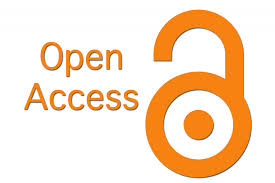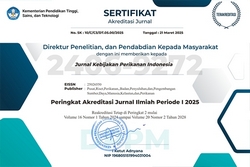FUNGSI FISH SHELTER SEBAGAI PERLINDUNGAN HABITAT SUMBAR DAYA IKAN KARANG DI KABUPATEN BREBES
Abstract
Fish Shelter atau hunian ikan merupakan struktur bangunan bawah air yang dibuat secara permanen dan dirancang untuk berperan sebagai tempat berlindung bagi ikan, terutama ikan-ikan demersal dan karang. Fungsi dari fish shelter ini sebagai alat untuk mengembalikan kesuburan dari habitat dan ekologi sekitar pesisir pantai. Tujuan dari penelitian ini adalah pemulihan stok sumberdaya ikan melalui tempat perlindungan ikan (fish shelter) untuk pemanfaatan yang berkelanjutan. Metodologi pengumpulan data dilakukan pencatatan langsung hasil tangkapan di sekitar fish shelter oleh nelayan sebagai enumerator, selama 8 bulan dari bulan Maret – Oktober 2023. Semenjak fish shelter ditempatkan tahun 2015 lokasi tersebut selalu ada kegiatan penangkapan ikan. Fungsi fish shelter menjadi tempat mencari makan (nursery ground) dan perlindungan (shelter) yang baik untuk beberapa ikan demersal, seperti kakap, kerapu, kuro dan lain-lain. Frekuensi penangkapan menjadi lebih banyak, dan dalam waktu 1 jam dapat di tangkap 5 – 8 kg ikan. Jumlah ikan ekonomis penting yang ditangkap nelayan adalah yang terbanyak disekitar fish shelter ikan kakap sebanyak 1.729 kg, kerapu 165 kg, cracas 1.234 kg, layang 726 kg, dan kuro (senangin) 125 kg. Komposisi berat ikan demersal 54,80 % dan ikan pelagis 45,20 %. Fish shelter yang di perairan Brebes, sangat bermanfaat untuk mengembangkan perikanan karang atau demersal ditandai dengan hasil tangkapan nelayan jenis ikan ekonomis penting disekitar fish shelter.
A fish shelter is a permanently constructed underwater structure designed to act as a refuge for fish, especially demersal and reef fishes. The function of this fish shelter is as a tool to restore the fertility of the habitat and ecology around the coast. The aim of this study is the recovery of fish stocks through fish shelters for sustainable utilisation. The methodology for data collection was direct recording of catches around the fish shelter by fishermen as enumerators, for 8 months from Maret to November 2023. Since 2015 the fish shelter the location has any fishing activities. However, the fish shelter fungsion provides a good nursery ground and shelter for several demersal fish, such as kuro, snapper, grouper and others. The frequency of fishing becomes more, and within 1 hour, 5 - 8 kg of fish can be caught. The number of economically important fish caught by fishermen was the highest around the fish shelter with 1.729 kg of snapper, 165 kg of grouper, 19 kg, 1.234 kuwe, 726 kg layang and 125 kg of kuro (senangin) fish. The weight composition of demersal fish was 54.80 % and pelagic fish was 45.20 %. Fish shelters in Brebes waters are very useful for developing reef or demersal fisheries, indicated by the catch of economically important fish species around fish shelters.
Keywords
Full Text:
PDFReferences
Alatas, U., Mardjudo, A., Ihsan, T., & Ekaputra, A. (2022). Teknologi penangkapan ikan demersal dan aspek ekonomis hasil tangkapan nelayan di kelurahan ganti kecamatan banawa kabupaten donggala, sulawesi tengah demersal. Jurnal TROFIS. DOI: https://doi.org/10.31970/trofish.v1i2.103
Aneesh, P.H., Bose, J.W., Alex, B., Fabrizia, R., Adrian, I., Walter, S., & Alex, J. (2020). Structural manipulations of a shelter resource reveal underlying preference functions in a shell-dwelling cichlid fish. Proceedings B. Departement of Collective Behaviour, Max Planck Institute of Animal Behavior, Kanstanz, Germany Zoological Institute, University of Basel, Basel, Switzeland. https://doi.org/10.1098/rspb.2020.0127
Boahen-Adu Kofi., & Jonah, F.E. (2014). Coastal environmental injustice in Ghana: the activities of coastal sediment miners in the Elmina, Cape Coast and Moree area. GeoJournal 81(2). DOI:10.1007/s10708-014-9612-4
Chumnarn, P., Kenji, M., & Virgilia, T.S. (2011). Steering the Development of Southeast Asian Fisheries Towards Sustainability. Fish for the People. Southeast Asian Fisheries Development Center (SEAFDEC). 9 (2), 1685-6546. Page 14. URI http://hdl.handle.net/20.500.12066/7427
Dewanti, P. L., Fathurrahman, H., Khan, A., Apriliani, M.I., & Herawati, H. (2020). Kepadatan stok ikan demersal menggunakan alat tangkap dogol di kabupaten pangandaran fakultas perikanan dan ilmu kelautan, Universitas Padjadjaran, ALBACORE. 3, (3), 241-248.. DOI:10.29244/core.3.3.241-248. Corpus ID: 213553178
Faizah, R., & Hargiyanto, I. (2018). Komunitas penempel pada modul terumbu buatan di perairan teluk awang dan teluk bumbang nusa tenggara barat. Rehabilitasi Ekosistem Terumbu Karang Untuk Kebrlanjutan Sumbedaya Perikanan. Amafrad Press Badan Riset Dan Sumberdaya Manusia Kelautan Dan Perikanan Gedung Mima Bahari III Lt 6 Jalan Medan Merdeka Timur No. 16 Jakarta Pusat 10110 Tlp (021) 3513300 Fax 3513287 Email Amafradpress@Gmail.Com No Ikapi: 51/DKI/2014.
Gislason, H., & Rice J. (1998). Modelling the response of size and diversity spectra of fish assemblages to changes in exploitation. ICES Journal of Marine Science, 55: 362–370. https://doi.org/10.1006/jmsc.1997.0323
Harahap, A.Z., & Susetya, I.E. 2020. Marine ecotourism potential in unggeh island tapanuli tengah regency, North Sumatra, Indonesia. Study Program of Aquatic Resources Management, Faculty of Agriculture, Universitas Sumatera Utara, Medan, North Sumatera. Indonesia. JIPK. 12 (2). https://doi.org/10.20473/jipk.v12i2.17940.https://ejournal.unair.ac.id/JIPK/index.
Kuiter, R.H. & T. Tonozuka. (2001). Pictorial guide to : Indonesian Reef Fishes. Zoonetics Publc. Seaford VIC 3198. Australia. https://doi.org/10.20473/jipk.v12i2.17940
Latuconsina, H., Nessa MN., & Rappe RA. (2012). Komposisi spesies dan struktur komunitas ikan padang lamun di Perairan Tanjung TiramTeluk Ambon. Jurnal Ilmu dan Teknologi Kelautan Tropis. 4(1): 35-46. DOI: https://doi.org/10.29244/jitkt.v4i1.7804
Millidine, J. J. D, Armstrong, D., & N. B. Metcalfe N. B. (2006). Fish Biology Group, Division of Environmental & Evolutionary Biology, Institute of Biomedical & Life Sciences, Graham Kerr Building, University of Glasgow, Glasgow G12 8QQ, UK, and ‡Fisheries Research Services, Freshwater Laboratory, Faskally, Pitlochry PH16 5LB, UK Functional Ecology 2006 20, 839–845. https://doi.org/10.1111/j.1365-2435.2006
Mahulette, R., Thomas., Panggabean, Anthony, S., Nugroho, D., & Lubis, N.R. (2017). Dampak pemasangan hunian ikan buatan sebagai upaya pemulihan habitat sumberdaya ikan demersal di perairan pantai brebes, Jawa Tengah. 9 (1), 31-40. : 10.15578/jkpi.9.1.2017.31-40 |
Manik, M. H., Sujatmiko, N.T., Ma’mun, A, Priatna,A. (2018). Penerapan teknologi hidroakustik untuk pengukuran sebaran spasial dan temporal ikan pelagis kecil di laut banda. Marine Fisheries. 9(1), 39-52. DOI: https://doi.org/10.29244/jmf.9.1.39-52
Nybakken, J.W. (1992). Biologi laut, suatu pendekatan ekologis. PT Gramedia Pustaka, Jakarta.http://kin.perpusnas.go.id/DisplayData.aspx?pId=3887&pRegionCode=UASA&pClientId=113
Nybakken, J.W. (1993). Intertidal Ecology. Marine Biology: An Ecological Approach (ed. J.W. Nybakken), pp. 219 –282. URI: https://lib.ui.ac.id/detail?id=140738
Priyambodo, U. (2021). Studi baru khawatirkan keberadaan ikan kakap dan kerapu di laut Jawa. Nationalgeographic.co.id. http://nationalgeographic.co.id/
Sidibé A. (2010). Evaluation-test sur l’utilisation de la Liste Rouge de l’UICN comme outil de suivi des risques de perte de biodiversité : Application aux espèces de poissons démersaux côtiers exploités en Afrique du Nord Ouest. Rapport du Programme marin et côtier pour l’Afrique Centrale et Occidentale ; 58 pp. DOI:10.1007/s10708-014-9612-4.
Sutikno, (1993). Karakteristik bentuk dan geologi pantai di Indonesia. DIKLAT PU WIL III. Dirjen Pengairan Pepartemen PU. Bentuk dan Geologi Pantai di Indonesia. DIKLAT PU Yogyakarta. 51 Hal. DOI: doi.org/10.21009/03.SNF2017.02.EPA.20
Suwarso & Hariati, T. (2003). Biologi dan ekologi lkan pelagis kecil di Pantai UtaraJawa Barat dan Selat Sunda. J.Lit.Perik.Ind. 9(7): 29-36. DOI:10.15578/jppi.26.4.2020.189-199
Seafdec. (2011). Fish for the People. A Spescial Publication for the promotion of sustainable Fisheries for Food Security in the ASEAN Region. Southeast Asian Fisheries Development Center (SEAFDEC). 9 (2), 2011 (Special issue), Bangkok Thailand issn: 1685-6546.
Vatria Balvia, (2010). Berbagai kegiatan manusia yang dapat menyebabkan terjadinya degrada ekosistem pantai serta dampak yang ditimbulkannya. Politeknik Negeri Pontianak. https://www.researchgate.net/publication/329178928
Zulham, A., & Subaryono. (2017). Pengembangan perikanan tangkap Laut Kota Kendari Depok: Rajawali Pers. hlm. 56. ISBN 978-602-425-447-6.
DOI: http://dx.doi.org/10.15578/jkpi.17.1.2025.%25p

Jurnal Kebijakan Perikanan Indonesia is licensed under a Creative Commons Attribution-ShareAlike 4.0 International License.
View My Stats
p-ISSN 1979-6366
e-ISSN 2502-6550














